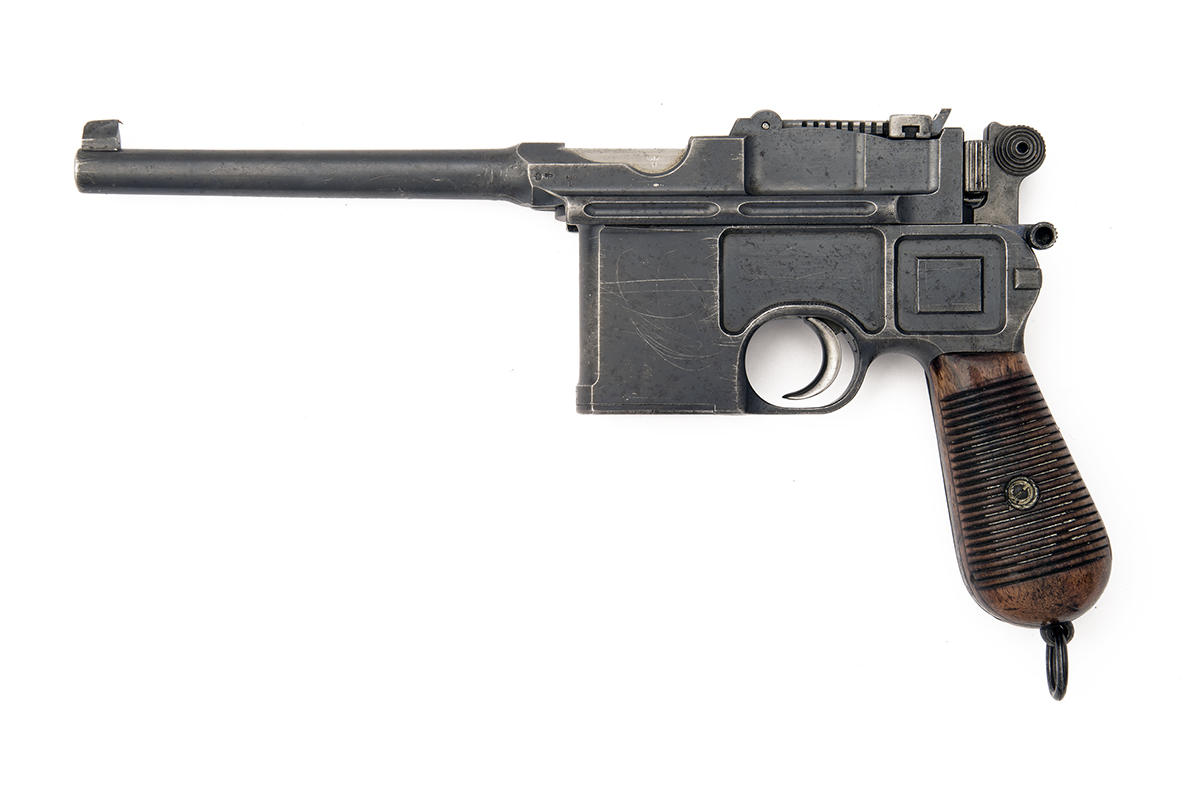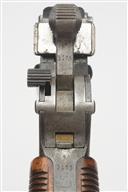Product Details
MAUSER, GERMANY
A 7.63mm (SMOOTH) SEMI-AUTOMATIC PISTOL, MODEL 'C96 CONE-HAMMER 'BROOMHANDLE'', serial no. 3175, WITH HOLSTER-STOCK,
for 1897, with blued tapering 5 1/2in. nitro reproved barrel (smoothbored from rifled), brushed bright bolt with long blued extractor claw, variant rear-sight marked '1' through '10', cone hammer with old style safe, milled receiver with integral magazine, walnut bag-shaped grips with 23 grooves, fair amount of faded blued finish remaining, complete with its matching number walnut holster stock (cracked along left side) and a leather harness complete with cleaning rod, the harness dated 1918
Provenance: The vendor has kindly supplied the following information on the pistol:
This pistol was formerly the property of Captain Geoffrey Malcolm Gathorne-Hardy MC. He was the son of the Conservative MP and Author Hon Alfred Gathorne-Hardy and Isabella Louisa Malcolm and Grandson of Gathorne, Earl of Cranbrook. Alfred was a renowned fisherman and shot, Author of Travels in Argyllshire, contributor to the Fur, Fin and Feather Series and named in the Field as No.33 of the Top 100 Guns of All Time. Geoffrey grew up on the Kennet but spent his summers with his father and brother Alfred shooting in Argyllshire and further afield in Scandinavia. He was educated at Eton and New College Oxford where he was President of the Oxford Union in 1899.
He fought in the Boer War with the Royal Berkshire Regiment under General French, and was wounded in action. Recuperating after the war he went to Norway in 1905 on a hunting trip with his brother and to compete a research project he had begun at Oxford on the Norse Discoveries of America. He was there when the country gained independence, an event which began a lifelong love affair with Scandinavia and Norse history and Mythology, later learning Norwegian, Danish and Icelandic. In 1910 he travelled with the explorer, adventurer, writer and marksman H. Hesketh Prichard from Main, Newfoundland and Labrador to Indian House Lake on the George River, contributing to a chapter in Pritchard's Through trackless Labrador.
At the outbreak of World War 1 he rejoined his regiment. He served with honour, was mentioned in dispatches and was awarded the Military Cross and Croix de Guerre (Belgium). Early in the war he was seconded with his brother Alfred at Hesketh Prichard's request to a unit formed by the adventurer to improve the quality of marksmanship amongst the British army. Alfred and Prichard crawled through to enemy lines and retrieved samples of enemy protective firing plate. After early trials with the plate Hesketh Prichard was eventually successful in gaining official support for his campaign, and in August 1915 was given permission to proceed with formalised sniper training. Geoffrey continued to work with Prichard, training sniper units and with him establishing some of the early sniping protocols for the British Army as recorded in Hesketh Prichard's critically acclaimed Sniping in France, published in 1920. Returning to active duty Geoffrey was injured, loosing a foot in action and was awarded the Military Cross in 1918, while Alfred was killed at the Battle of Loos. Scarred by the death of his brother and the loss of many friends and colleagues he became a founding member of Chatham House and, with Lionel Curtis, Honorary Secretary from 1922.
He made a second journey to northern Labrador, this time with his cousin Robert Gathorne-Hardy, which he described in the Royal geographical Publication A Recent Journey to Northern Labrador. An important account, this represents the first recorded discussion on Labrador's ancient multi-tiered rectangular stone structures, which at the time were known to few very people and had no certain historical connection. Some 62 years after this discussion and the author's first observations, his theories of their makers were finally scientifically confirmed, the formations now being known to have been built by prehistoric Thule Neo-Eskimo people. This followed on from his work on the Norse Discoveries of America, which included research on Nordic Labradorian settlements. With his extensive Norwegian knowledge and language skills he was returned to non-active duty in World War II where he worked on Norwegian propaganda and acted as delegate to the Norwegian Government in Exile.
The Mauser dates from his Boer War service but is understood to have accompanied him on his expeditions and also during his active service in World War I. The family had a long relationship with Westley Richards, purchasing all their rifles from the company including Mauser Hunting Rifles. Westley and Richards were the agent for Mauser and it is assumed the Pistol was purchased directly from them.
Please click HERE to view Terms & Conditions. Please note all Lots are listed in accordance with UK Law, for overseas buyers, please ensure you are familiar with your relevant local firearms and customs regulations before bidding.
Estimate £800-1,200
S5 - Sold as a Section 5 Firearm under the 1968 Firearms Act, Sections 7.3 and 7.1 Eligible.
Unless prior arrangement has been made, two weeks after the Sealed bid sale, all Section 5 (and Section 7.1 / 7.3) items will be moved to a Section 5 carriers where storage charges will be incurred.
Goods will not be released until all outstanding charges have been met. Collection will be by arrangement.








